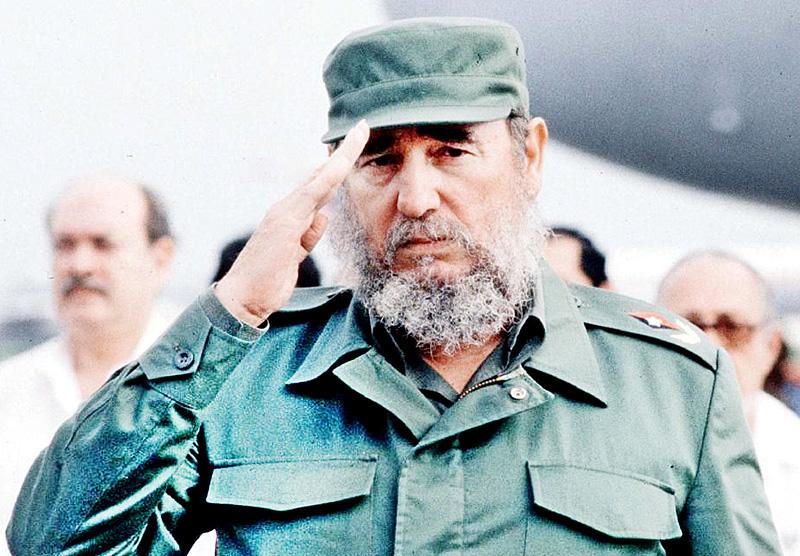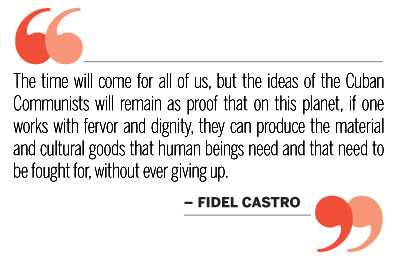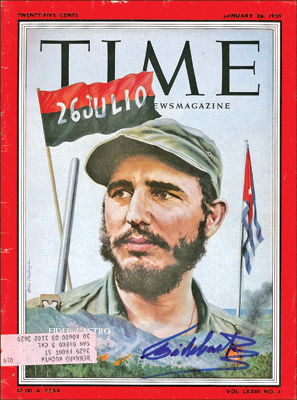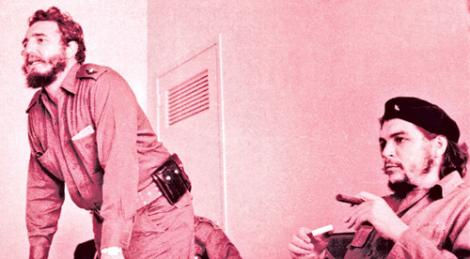
With a shaking voice, Cuban President Raul Castro said on state television, that his older brother died at 10:29 p.m. Friday local time. He ended the announcement by shouting the revolutionary slogan: “Toward victory, always!”

One of the world’s longest-serving rulers and modern history’s most singular characters, Fidel Castro who passed away on Friday at the age of 90 defied successive US administrations (in fact, 10 US Presidents) and assassination attempts. “El Comandante” Fidel Castro Ruz, was born on August 13, 1926 to a moderately affluent family, owners of a sugar-cane plantation in Cuba’s eastern Oriente province. His father, Angel Castro, was a self-made immigrant from Spain, and his mother, Lina Ruz, had been the family cook. Angel Castro had come from Spain’s impoverished Galicia province to fight for Cuban independence, and settled in the new nation in 1902, as a landless labourer.
 Fidel Castro on the cover of Time magazine in 1959 |
Castro, one of eight children, went to Catholic elementary school and graduated from Belen, a prep school in Havana, run by Jesuit priests. He excelled in both academics and sports, and was voted Belen’s best athlete in 1944. His preferred sport: the thoroughly American game of baseball.
He studied English in Santiago and practised by writing a letter to Franklin D. Roosevelt in 1940, which is now preserved in the US National Archives: “President of the United States. If you like, give me a ten-dollar bill green American.” He signed it, “Your friend, Fidel Castro,” and added, “If you want iron to make your ships I will show you the biggest mines of iron of the land. They are in Mayori, Oriente Cuba.”
Castro then went on to study at the University of Havana and earned a law degree. He also acquired a taste for politics as a student activist. “I was acquiring a socialist consciousness. I had initiatives, I was active and I struggled,” he recalled in a 1982 interview with Colombian journalist Arturo Alape. “But let’s say that I was an independent struggling person at that time.”
Castro plunged into the chaotic political scene of the day, joining violent student ‘action groups’. He was arrested, though never charged, in the 1948 slaying of another group’s leader. He joined abortive efforts to topple Rafael Trujillo’s dictatorship in the nearby Dominican Republic and took part in riotous protests in Colombia following the assassination of a presidential candidate there.
In 1952, Fulgencio Batista staged a military coup that established a military dictatorship and propelled Castro into the role of revolutionary. On July 26, 1953, Castro, Raul and 150 followers attacked the Moncada Barracks in Santiago de Cuba. The assault failed and many of Castro’s men were killed or captured. Castro was tried and sentenced to 15 years in prison.
On trial, Castro delivered a speech that became known by its final line. “I know that imprisonment will be harder for me than it has ever been for anyone, filled with cowardly threats and hideous cruelty,” Castro told the court. “But I do not fear prison, as I do not fear the fury of the miserable tyrant who took the lives of 70 of my comrades. Condemn me. It does not matter. History will absolve me.” Castro, freed in a 1955 amnesty, went into exile in Mexico where he recruited and trained guerilla fighters. That’s where he met Ernesto “Che” Guevara, an Argentine Marxist who would become synonymous with Castro’s revolution and in the process, become more famous than Castro himself.
The next year, Castro and more than 80 followers boarded a boat named Granma and landed in eastern Cuba, setting up camp in the Sierra Maestra mountains near his boyhood home. Dubbed the 26th of July Movement, the rebels seized weapons in attacks against Batista’s military and received food and shelter from sympathetic Cubans. Castro then began a slow march west, gaining in popularity as Batista was facing trouble all around. The U.S. government had lost faith in Batista, stopping arms shipments to him in 1958. On Jan. 1, 1959, Batista and his family fled Cuba.
That cleared the way for Castro, who marched into Havana amid throngs of supporters. He pledged to end corruption. He promised to improve living conditions. He had widespread support on and off the island, even as his true vision for Cuba remained a mystery. “Within the Revolution, everything; outside the Revolution, nothing”, said Castro.
Castro was treated to a hero’s welcome during a much-publicized tour of the U.S., where he rounded up support from liberals and curious fascination from many others. When Castro came to the US as Cuba’s new prime minister in April 1959, he woed the press, met then-vice-president Richard Nixon and reached through bars to pet a tiger at the Bronx Zoo. “It was a triumphal procession,” said Mark Falcoff, a former staff member of the Senate foreign relations committee and author of Cuba the Morning After: Confronting Castro’s Legacy. “He was the most popular figure in the U.S.”
He then began Cuba’s transformation to communism, aligning itself with the Soviet Union. The new government nationalized businesses and banks, confiscating more than $1 billion in American-owned property. One of Castro’s first pronouncements upon taking control of Cuba was that all citizens would have free access to an education and healthcare. Castro made it a priority to ensure that every Cuban — poor people in cities, farmers in isolated provinces — had full access to schools and hospitals. And even though both sectors suffered later due to unrelated economic troubles, those institutions endured. Cubans’ life expectancy is over 77 years, ranking it higher than more developed Latin American countries like Mexico, Argentina and Chile. And Cuba has the highest literacy rate in Latin America (99.8%), according to the CIA World Factbook.

In the early years, Cuba’s vast sugar plantations sustained the economy. Cuba was the world’s largest sugar exporter for decades and the economy was further bolstered by the extraction of minerals, the tourism industry and the sale of the ubiquitous Cuban cigars and rum. Many wealthy Cubans left the country after the communist reforms were introduced and began to live mainly in Miami, USA, just 150 Km away. In January 1961, the United States broke off diplomatic relations with Cuba – these ties would be restored again only in 2016. Exiles in Miami, supported by the CIA, trained in the Everglades to topple Castro. In April of that year, 1,300 Cuban exiles made a disastrous invasion of Cuba at a southern coastal inlet, the Bay of Pigs.
U.S. intelligence acknowledged several failed attempts by the CIA to assassinate Castro between 1960 and 1954. The United States and the Soviet Union almost went to war over Cuba in 1962, after a U.S. U-2 spy plane photographed the construction of Soviet missile sites in what became known as the Cuban Missile Crisis. Kennedy ordered a naval blockade of Cuba to force Moscow to remove the missiles. Khrushchev agreed, in return for a U.S. promise not to invade Cuba and to remove U.S. missiles from Turkey.
 Fidel with Che Guevara |
In later years, U.S. efforts to dislodge Castro centered on economic and diplomatic measures. Tightened trade and travel restrictions replaced blockades. Tensions continued as Cuban exiles flooded South Florida at various times over the decades. More than 125,000 refugees flooded the United States in 1980 during the Mariel boatlift. In 1996, two planes flown by Brothers to the Rescue — a group that patrolled the Florida Straits for endangered rafters — were shot down by Cuban fighter jets. Castro claimed the planes violated Cuban air space.
The Elian Gonzalez saga took the political stand-off to an international stage. Eleven Cuban refugees headed for Florida died on Thanksgiving Day, 1999, including Elian’s mother. The 5-year-old survived. Elian’s relatives in Miami fought to keep him in the U.S., while his father in Cuba, with Castro’s fierce support, demanded his return. After a lengthy legal battle and a middle-of-the-night raid on Elian’s relatives’ house in Miami, the boy was sent home in June, 2000. The most stunning exodus occurred in the early 1990s, when tens of thousands of Cubans took to the high seas to avoid the economic conditions that followed the fall of the Soviet Union.
The Soviets also played a central figure, providing subsidies to the island through the height of the Cold War. Cuba’s economic flaws were exposed following the collapse of the Soviet Union in 1991. Castro instituted a series of reforms to avoid a similar situation - the government allowed some people to open private businesses, farmers were able to sell some products in the open market, rules barring foreign investment were loosened and Cubans were allowed to use the U.S. dollar to purchase items.
He formed a close bond with Venezuelan President Hugo Chavez, who saw Castro as the elder statesmen of Latin America. Among the other South American leaders who adored him were Evo Morales of Bolivia and Rafael Correa of Ecuador. In his later years, Castro sat on the sidelines as he watched his brother Raul institute many economic and social reforms after he stepped down from power. Fallow farmland was opened up for farmers to cultivate, more private business licences were granted, the country opened up to more foreign investment and in late 2010, Raul Castro’s government announced that up to one million Cubans — or about 20% of the work force — would be removed from the state payroll and allowed to further expand the private business sector.
Castro’s supporters regarded him as one of the most effective revolutionary leaders in Latin America. They cite his vast accomplishments in education and healthcare — two tenets of Castro’s socialist system that provide both services free of charge to Cubans. Despite years of economic difficulties following the fall of the Soviet Union, Castro still held an extraordinary sway over his people. ‘Fidelismo,’ or a kind of personality cult around Castro, managed to survive.
Just before his 2006 surgery, Castro gave a series of interviews to Spanish journalist Ignacio Ramonet, who asked Castro about his perception as a “cruel dictator” by many around the world. “I honestly believe that a man who has dedicated his entire life to fight against injustice, against the oppression of every man, who serves others, who fights for others, who practises solidarity — I think all of that is incompatible with cruelty,” Castro said.
Castro lived to see the full restoration of diplomatic relations with the US and the visit by US President Barack Obama, though he essentially did not approve of the visit. He made this known in an opinion piece he wrote to the Granma newspaper, to which he contributed regularly. Direct flights between the two countries began this year, but most sanctions still remain. With President-elect Donald Trump adopting a more hardline attitude towards Cuba, a full lifting of sanctions may not materialize. Throughout his rule, Castro remained a thorn in America’s side, unchanged and unbowed even after the disappearance of the USSR, which had been Cuba’s guiding light, greatest ally and No. 1 trade partner. Hundreds of thousands turned out for Castro’s speeches, hearing his high-pitched voice soar hour after hour. He would walk listeners through world history, dip into provincial cane-cutting statistics, chuckle about his foes and then thunder about capitalist injustice. His 269-minute address to the UN General Assembly in 1960 set the world body’s record for length, a mark that is unlikely to be broken.
A severe gastrointestinal illness in 2006 nearly killed Castro, forcing him to turn power over to Raul. Fidel remained a strong presence, penning hundreds of opinion pieces that were dutifully reprinted in every Cuban newspaper and read out in their entirety on the evening news. He was seen looking frail and unsteady at a Communist Party summit in April 2011 in which he formally relinquished his final office as party leader. He had already relinquished the presidency in 2008.
To the end, Castro remained a polarizing figure. For many he was a champion of the poor who along with Ernesto “Che” Guevara made violent revolution a romanticised ideal, a symbol of liberation who overthrew a dictator and brought free education and healthcare to the masses. To exiles who longed for Castro’s demise he personified a regime that locked up political opponents, suppressed civil liberties and destroyed the island’s economy. But, there is no denying that Castro played an out-size role on the world stage for much of the 20th century, all from an island, smaller than the US state of Pennsylvania.
